7 Tried Employee Engagement Ideas & Tactics for Managers
In 2020, 14% of employees were actively disengaged, according to Gallup’s research. Come 2021, in the aftermath of COVID-19; it rose to 15%.
You might think this increase is minor and negligible.
After all, it is just 1%.
Well, that would be an erroneous assumption for any manager to make. And that’s because, in the employee engagement world, 1% makes a lot of difference. In fact, a Global Employee Engagement report shows that for every 1% increase in engagement, companies see an additional 0.6% in sales growth.
That’s evidence to prove that slight improvements in your team’s engagement level can lead to more revenue outcomes.
Apart from the increased financial growth of your company, engaged employees tend to be long-term. A TechJury’s findings reported that highly engaged employees are 87% less likely to leave their places of work.
In light of this, it is no wonder that the search volume for what brings you here today, ‘employee engagement ideas,’ has been high for over a year now:
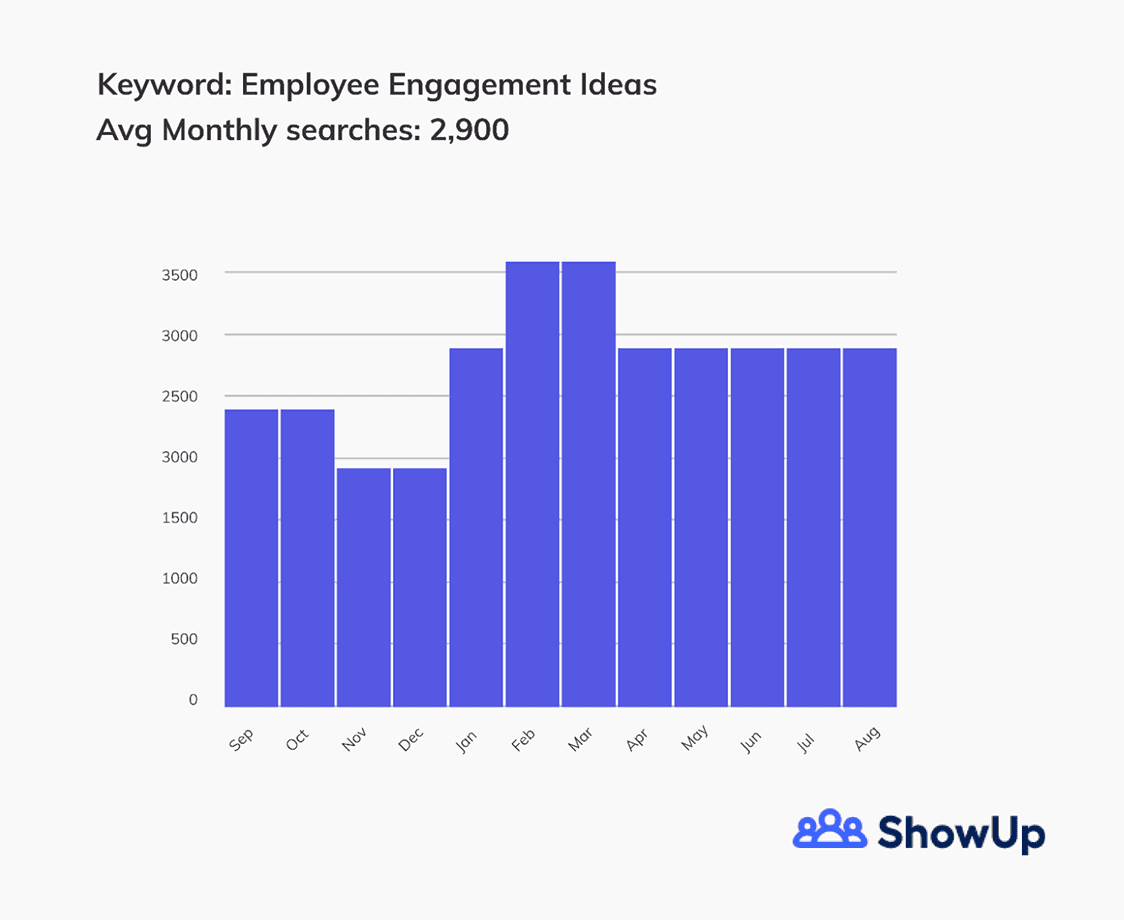
This high (and rising) monthly search volume should tell you something.
Many people, including managers like you, are trying to improve employee engagement to retain their top talent. Unfortunately, most information available via Google search is generic and not in tune with post-COVID-19 realities.
But that’s where this article comes in.
First, I’ll share practical employee engagement tactics managers (like you) can rely on today. Also, you’ll see how to track and act on different metrics to increase engagement among your employees with team pulse surveys:
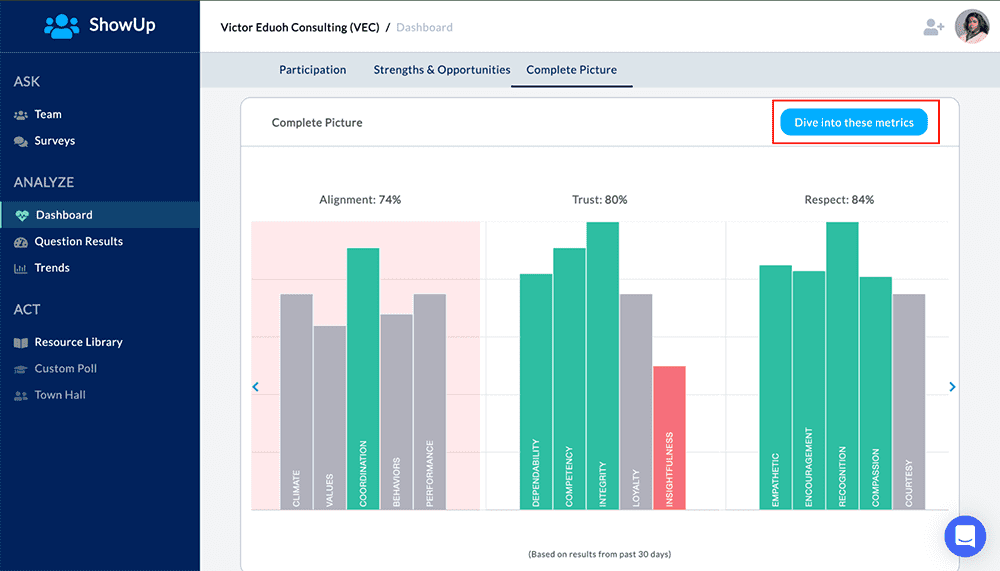
Automatically Measure & Get Real-time Insights for Improving Employee Engagement
Table of Contents:
Employee Engagement Ideas and Tactics
Ken Royal, a Senior Client Service Manager & Partner at Gallup, said:
The manager is either an engagement-creating coach or an engagement-destroying boss. Both relationships affect employee behavior.
Let me rephrase that for you.
Ken is saying that as a manager, you can influence the engagement levels of your employees.
Don’t know where to start?
Below are seven employee engagement ideas you can try today. Besides helping you boost engagement and instill passion in the workplace, these tactics are practical and suitable for physical, remote, or hybrid work environments.

1. Define Goals & Expectations
You may be wondering: ‘What has defining goals and expectations got to do with an employee engagement tactics list’?
I know, it sounds so cliché.
However, defining and writing down your goals is a proven way to improve engagement among workers. In other words, setting SMART (Specific, Measurable, Attainable, Realistic, and Timely) goals can do wonders to engage your employees.
In case you’re in doubt, look at this for a moment.
A London Business School survey of 11,000 managers and executives showed that only a third could name their firm’s top priorities. You think that’s bad? Well, another study by HBR revealed that only 16% of employees have a clear understanding of their corporate priorities.
Clearly, there’s a disconnect between what individuals are working on and what organizational objectives require.
Let me ask you a question to this effect.
How engaged would you be if you realized everything you’ve been working on in the past three months didn’t align with your organization’s goals?
Not so engaged right?
The employees you manage also feel disengaged when they discover their priorities and the organizations’ are misaligned. This is why setting and communicating SMART employee engagement goals ensures all involved parties are aligned and work together to boost engagement.
2. Employee Recognition
Saying ‘Great Job!’ to your workers after a project goes a long way in improving engagement. Like Kate Nasser, The People Skills Coach™ said:
To improve employee engagement, capture the magic of the I’s in the team. These are integrity, initiative, individual talents, and invaluable diversity. Highlight each individual’s talents and how they contribute to the whole.
A study conducted by Cicero proves what Kate said above.
Their research revealed that 80% of employees were highly engaged when recognized by their managers.
All of this points to your employees’ craving recognition and praise after a job well done. Unfortunately, according to Gallup, over 65% of employees hadn’t received any form of recognition in the previous year.
Having a recognition program in place makes rewarding employees easier.
However, you must keep a close eye on this program as it could get outdated. And this is because, for a reward program to be most effective, managers have to keep their fingers on employees’ pulses.
Creative Group Inc’s experience can tell you more about the importance of this. Previously, they had a recognition and reward program for employees in place. But after they measured the pulse of their employees, they discovered a need to overhaul the program. It wasn’t working for the employees anymore.
What was their next step?
First, they set up their SMART goals (like we’ve already discussed above).
These goals included:
- Redesigning the current program to create renewed excitement. And then combine its disparate programs onto a single, easy-to-use platform.
- Increasing participation by 50%.
- Driving behaviors aligned with the company’s mission and strategic pathways.
- Recognizing and rewarding employees through social recognition.
Then, they developed a newer program called Excelevate to honor and recognize employees.
Some results of this move?
Increased employee engagement by 92.4% (more than double the previous year). Also, they had the best sales year in the company’s history and more positive customer metrics.
Those are some pretty impressive results.
Another real example of a company doing well with employee recognition is Infinite Red. A remote company, Infinite Red has a #kudos Slack channel. On this channel, they celebrate their employees’ wins and hard work. Take a look below:
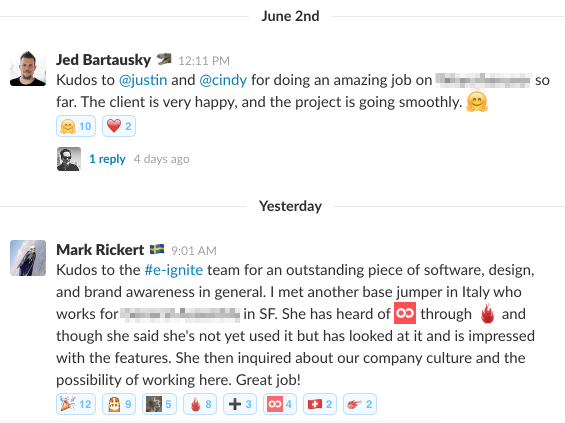
You’ve seen the direct correlation between employee recognition and an engaged workforce.
What next?
Start rewarding your team members. Acknowledge their efforts. A pro-tip to keep in mind is to praise your employees loudly and publicly but criticize them privately.
3. Allow for Unplugging
It might seem counterintuitive, but rest is productive.
Unplugging involves resting from work and focusing brainpower on other activities. In a roundabout way, it makes sense to unplug as a way to increase productivity and engagement.
AI Researcher, Writer, and Digital Creative Max Frenzel, Ph.D. wrote:
Excellent work needs rest and relaxation just as much as it requires time engaged in work. When we rest, our brain is busy consolidating memories and searching for solutions to problems we encounter.
Unplugging is even more important for remote workers in the post-pandemic era. This is because work-life balance for remote workers can become a myth.
Look at it this way.
When work and home are in the same location, one can be tempted to work at all times. In such a case, it is necessary to create and maintain boundaries between work and home.
But the sad reality, as per Buffer’s study, is that over 21% of remote employees have been unable to unplug from work since 2020. This problem will only worsen, and it has severe consequences like disengaging and disconnecting employees.
As the manager, you must enforce this work-life balance.
Like Terry McDougall, an executive coach, says:
Managers should proactively state that they want their employees to place boundaries between work time and home time.
One way of enforcing this balance is to make sure every employee takes their annual leave. If they fail to do this, they are going to get burned out and disengaged.
4. Celebrate Employees’ Birthdays & Anniversaries
Your company probably has two or three dozen things to celebrate as a business or work team. A huge project milestone, a revenue jump, or an increase in net sales offer good reasons to have a party.
However, what these events lack is a focus on one employee.
For engagement purposes, it’s crucial to focus on celebrating the epiphany moments of each employee you manage.
But first, what are epiphany moments?
Epiphany moments are dates or events that cause people to reexamine their life choices. This includes birthdays, anniversaries (work and personal), and milestones.
What makes birthdays a natural time to reflect on our lives and careers?
For many people, adding another year to their life prompts internal reflection. It should interest you to know birthdays are one of the three days employees are most likely to quit their jobs.
With turnover at an all-time high, managers shouldn’t take birthday celebrations lightly. Instead, see these events as opportunities to engage employees better and show them they’re appreciated members of your team.
According to Azza Shahid, Digital Marketer at Physicians Thrive:
Celebrating different professional and personal milestones is key to maintaining morale and making [employees] feel valued.
Based on this reasoning, it is not a stretch to say employees that feel valued are more likely to be engaged because of the emotional connection they develop to the company.
In short, Azza went on to say:
We make sure to remember employees' birthdays, anniversaries with the company. We recognize them by sending a personalized card or email on the company account. Sometimes, we mention it in online team meetings. These are small things but are a great motivation-booster.
Louie Martinez, HR Business Partner at Quartet Health, agrees with Shahid:
His exact words are:
Being recognized at a company for years of service is really thoughtful, and people like that call-out
5. Invest in Training and Learning Opportunities for Employees
Let me tell you the truth.
Employees (like myself crafting this article) value training opportunities just as much, if not more, than their employers. The modern professional knows the recipe for a successful career is ongoing learning and growth. Yet, companies often fail to provide their employees with the proper tools for development.
The stats show that:
- 74% of workers are willing to learn new skills or re-train to remain employable.
- 59% of millennials claim development opportunities are significant when deciding whether to apply for a position, and
- 70% of employees would be somewhat likely to leave their current job to work for an organization that invests in employee development.
Apparently, failure to invest in employees’ personal development puts you at high risk of skewing their engagement levels and losing them.
Elise Spaulding, director of learning and performance at The Reserves Network, explained the reason behind this:
The nature of hiring, training, and working in our culture is shifting. With these employment market changes, businesses need to ensure they don’t lose good employees to their competitors. Upskilling is a great way to invest in your employees. Not only does it help your business, but it shows your interest in contributing to the career of your staff.
How do you (the manager) come in?
An INSEAD study found that empowering employees was the number one trait millennial employees want in a manager. And Bob Nelson, Ph.D., and a leading authority on employee engagement agree.
Bob Nelson wrote:
Employees need to know that their manager is interested in their development. Also, he is willing to periodically take time to discuss and encourage their progress. This includes learning and potential career paths.
Investing in your employees is a powerful employee engagement tactic.
No wonder, Bob Nelson, Ph.D., in his book “1,001 Ways to Engage Employees,” further revealed:
I did a regression analysis of three million employee surveys. Then I found that the second-most significant driver of employee engagement is career development. That is learning, development, and advancement opportunities that are provided to employees on a systematic basis.
In summary, training your employees is a good idea. This is because it will have a positive impact on their engagement levels.
6. Side Projects & Brainstorming Sessions
Hear me out.
I know you’re eager for employees to do their jobs. But sometimes, your employees aren’t engaged because they are bored with said job.
Yup.
Even a job that you love doing can get monotonous, and this, according to research reported by HBR, has been attributed as a major cause of burnout.
Your staff can certainly do with some spice in their work life.
Don’t believe me?
Well, let’s see what O.C. Tanner’s 2018 annual global report of 14,000 workers in 12 countries revealed. The study found that 41% of employees would forgo a promotion if they could have more variety in their day-to-day work.
A great way to bring that variety into the work environment is by encouraging pet/special projects.
Pet projects are personal projects that appeal to employees.
They may or may not be work inclined, but they have a way of engaging employees. From the O.C. Tanner report above, participants reported that their leaders connecting them with pet projects increased the odds of engagement by 837%.
When commenting on the result of the report, the organization’s Vice President, Gary Beckstrand, wrote:
Special projects let employees learn new skills, as well as use their existing abilities in different ways. They allow workers to connect with colleagues with whom they might not otherwise work with. Also, it produces feelings of success by making a meaningful impact on the company and its mission.
Beyond encouraging side projects, hold regular brainstorming sessions. Doing this is another excellent way to foster innovation in your workplace, engage employees, and ensure job satisfaction.
David Henningsen & his wife, Mary Lynn Henningsen, both researchers at Northern Illinois University, conducted a study on brainstorming.
The researchers said:
Brainstorming can be used to help a team buy into and implement a plan of action,” Henningsen said. Or it can be used to simply build cohesiveness. In turn, this can lessen employee turnover and increase employee commitment.
7. Give Employees A Voice
Do you know managers account for 70% of the variance in employee engagement? In other words, as a manager, you have the highest influence on how engaged employees are.
That’s a lot of power in your hands.
To avoid misusing that power as a manager, ensure your engagement efforts align with a workplace environment employees need to do their best work.
However, unless you are Professor X, you cannot read minds.
And this makes it difficult to know what your employees' thoughts are. So, the best way to get feedback from employees is to create a safe space, give them a voice to speak, and listen to them.
I call this the ultimate employee engagement tactic.
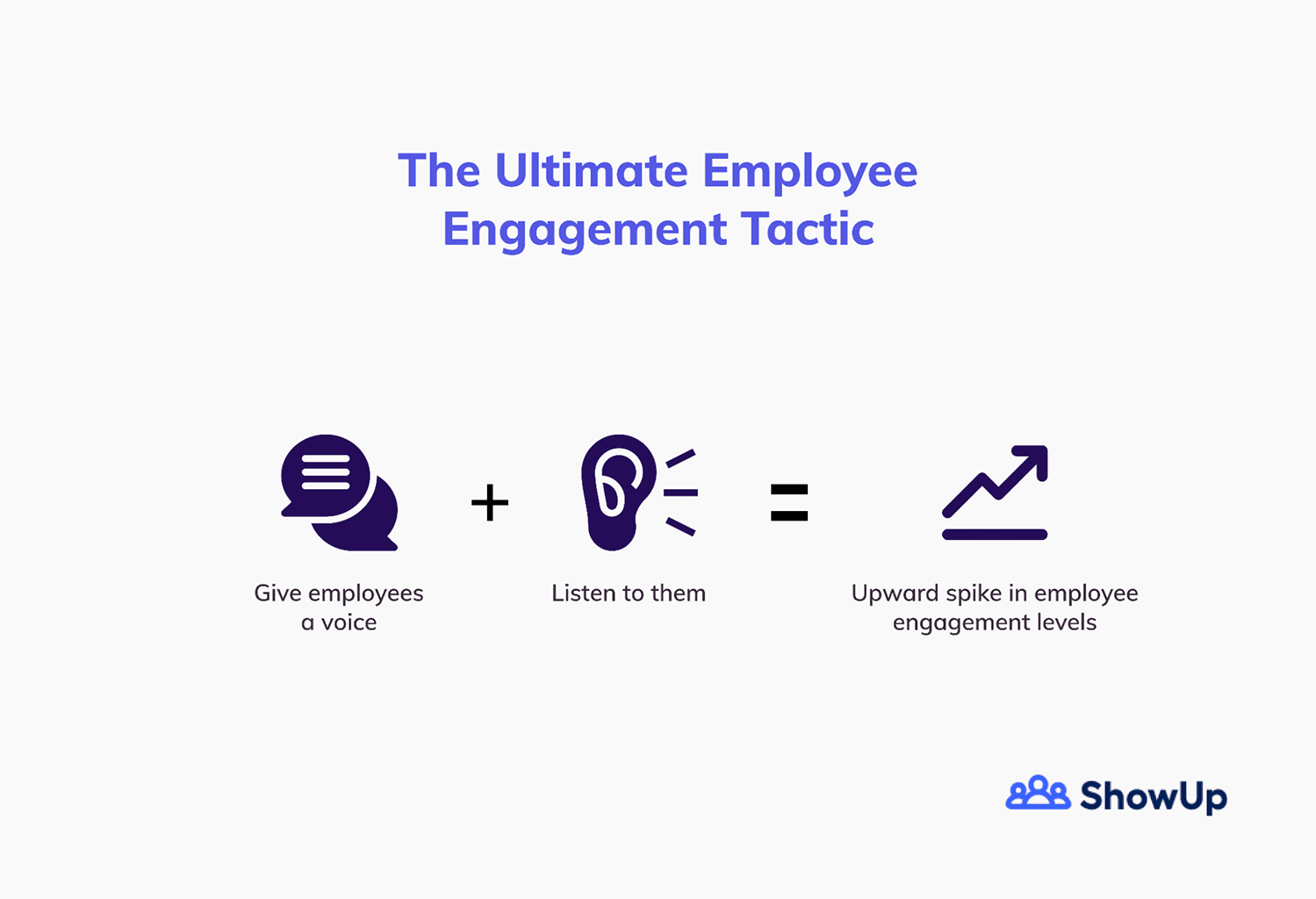
That’s because when you allow employees to express their thoughts freely and you act on these thoughts, engagement levels head north. Listening to employees and equally giving them a safe space to speak is vital to employee engagement.
Now, I’m not referring to a literal safe space.
I’m referring to a way employees can communicate with you while maintaining anonymity. This includes receiving anonymous feedback, analyzing it, and taking action on what they share.
If you’re a manager with over ten employees, doing all that together with juggling other managerial duties can be quite tasking to do. A way out is to leverage employee engagement software to automate this tedious task.
And don’t take it from me.
According to Achiever’s report, over 64% of HR leaders agree that an engagement listening tool is essential to boosting engagement.
One of such tools is ShowUp, an automated team pulse survey software.
ShowUp does one thing exceptionally well.
And that’s helping you give employees a voice. Our software also analyzes the feedback and helps you track metrics relevant to improving staff engagement:
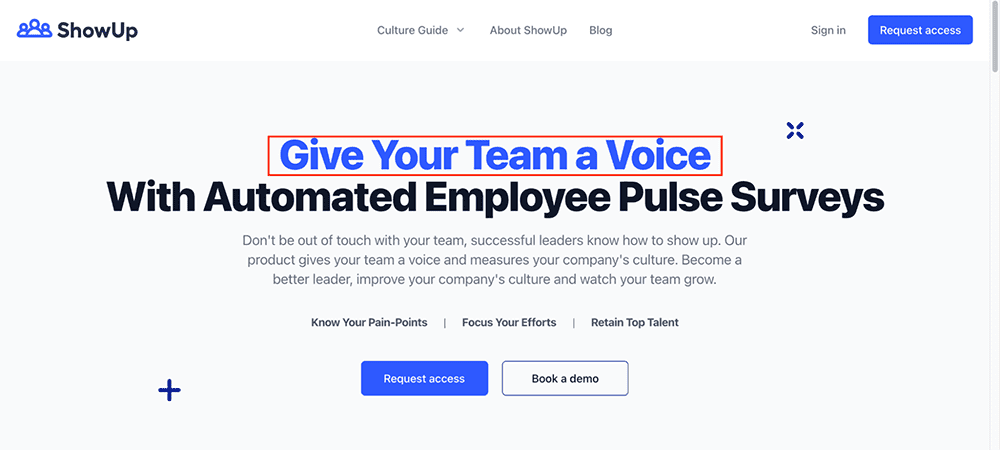
Give Employees a Voice
Use ShowUp to get timely insights to improve engagement regularly
Would you like to see how giving your team a voice via pulse surveys is an excellent employee engagement idea?
Check it out below:
How Pulse Surveys Give Employees a Voice (and Boosts Engagement)
A pulse survey is a brief and regular set of questions sent to employees.
As the term “pulse” suggests, it is carried out regularly to measure employees’ always-evolving emotions in the workplace. Also, doing it continuously helps you gain employees’ views on the company’s culture.
But more importantly, you can use pulse surveys to quickly ascertain your employees’ engagement levels and drivers.
For instance, Founder & Chief Scientist at Culture Amp, Dr. Jason McPherson, believes asking a range of questions on a specific topic (e.g., employee engagement) provides the full view of the topic.
He said:
In general, statisticians agree that well-constructed, multiple-item indicators are more reliable. They also tend to provide better external validity than single-question metrics
Dr. Jason is essentially saying that pulse survey questions should be diverse for a more accurate picture.
And ShowUp’s pulse surveys follow this advice.
Weekly or bi-weekly (depending on your preference), with ShowUp, you can adjust and automate relevant surveys that give your entire team a voice. Pulse surveys can be sent weekly or bi-weekly.
Your employees get these delivered right to their inboxes:
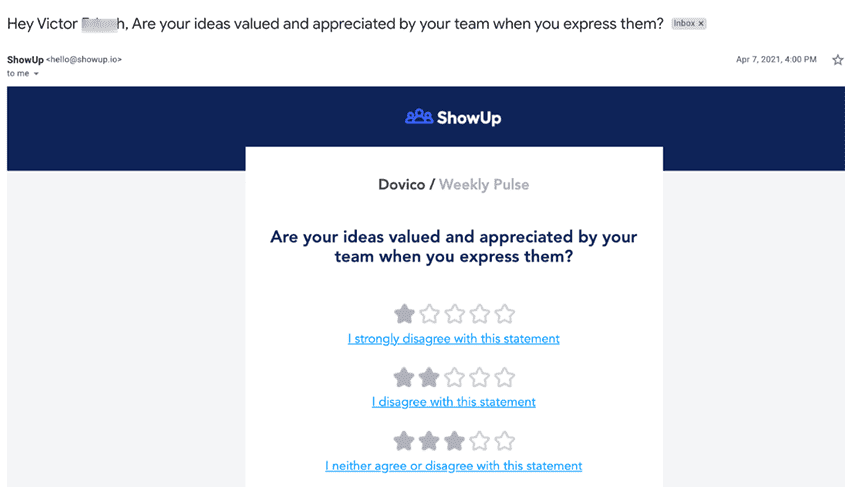
Survey questions are sent via email to recipients.
These surveys contain 6 well-researched, diverse, and psychology-backed questions. As stated earlier, the aim is to give your employees a voice, analyze their feedback, and help you act on metrics that promote better culture and engagement.
A regular ShowUp pulse survey helps you track 6 metrics and 1 sub-metric each:
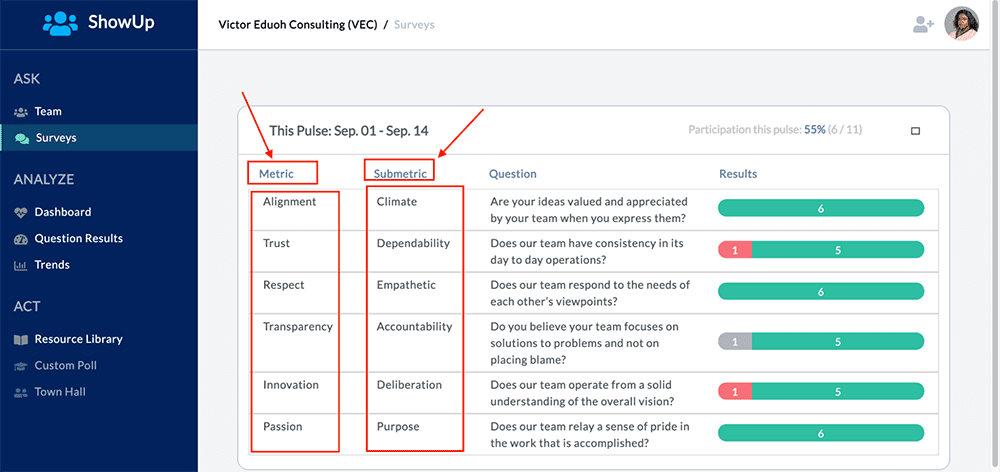
And to help you elicit honest and genuine responses, ShowUp’s surveys are 100% anonymous:
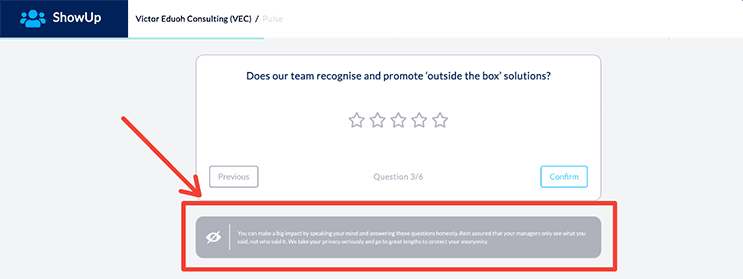
The average response rate for pulse surveys is 85%, while a regular engagement survey only gets around a 30% response rate. So obviously, pulse surveys are better at getting feedback and driving engagement.
Final Thoughts
As established, tracking your team’s pulse by giving them a voice helps you determine specific ideas relevant to improving engagement.
For instance, if you discover employees are feeling burned out, you can encourage side projects. And let’s say you wanted to see if lack of politeness was a reason why employees were getting disengaged?
Again, you can easily do this with ShowUp:
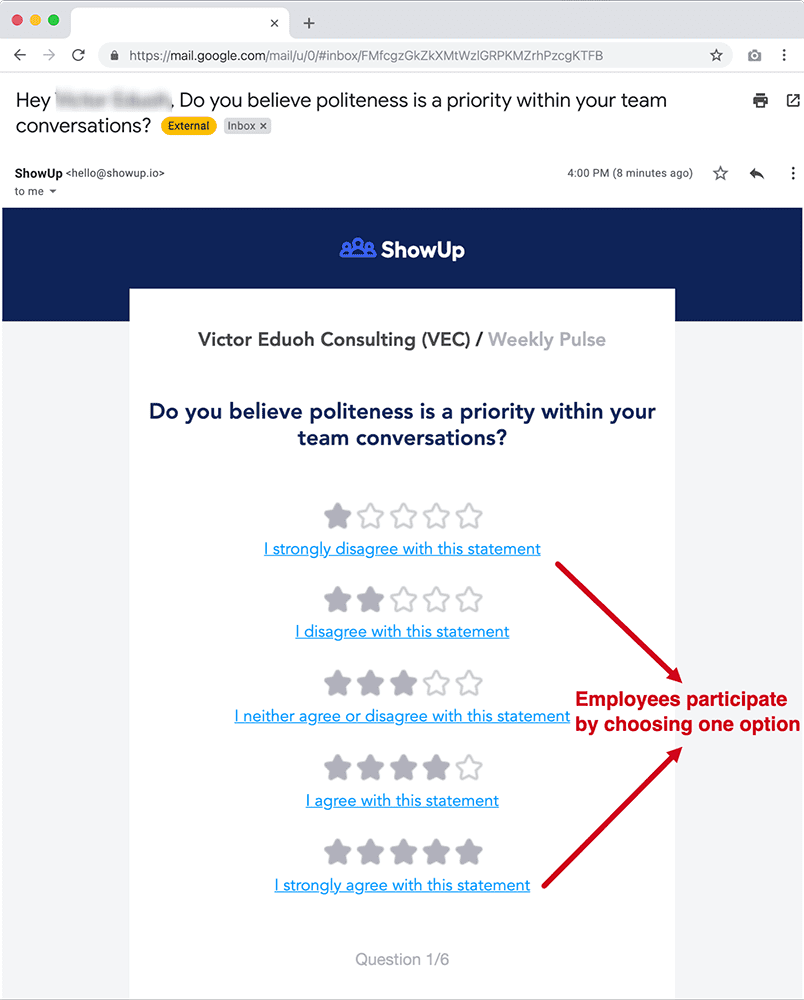
As your survey results come into your dashboard, you’ll see firsthand what your workers think about politeness. With this, you can brainstorm ideas to adjust.
However, let me add this.
It’s equally important to act on these pulse survey results immediately. As another research by Gallup found, when organizations send out internal surveys and hesitate to act on the response, they end up with lower engagement levels.
You can avoid that with ShowUp.
To simplify the process of taking action, ShowUp suggests helpful resources to help you fix identified engagement problem areas quickly:

